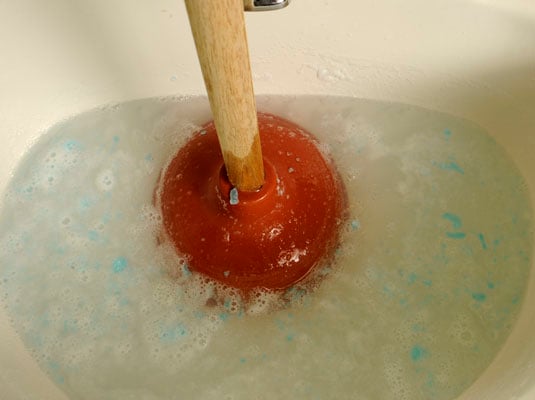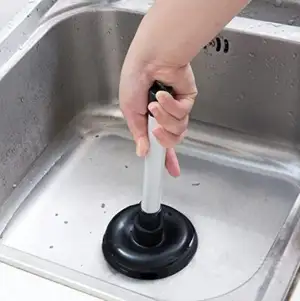Master Plunger and Drain Cleaners Strategies: Professional Tips
Master Plunger and Drain Cleaners Strategies: Professional Tips
Blog Article
Each person will have their private opinion in relation to A Guide to Plungers (and How to Use Them).

Introduction
Appropriate upkeep of house drains is crucial for preventing obstructions and making sure smooth water circulation. One of the key tools in every house owner's toolkit is the bettor, together with different drainpipe cleaners developed to tackle stubborn obstructions effectively. This short article explores just how to make use of plungers and drain cleansers properly to maintain your drains flowing openly.
Area 1: Comprehending Bettors
Kinds of Plungers
There are several sorts of plungers readily available, each created for different sorts of drains and obstructs. The most typical types include mug plungers, flange bettors, and accordion plungers.
Exactly How Plungers Job
Bettors work on the concept of developing pressure and suction to remove obstructions. When correctly applied over a drainpipe, they develop a vacuum that can pull out particles or separate clogs.
Choosing the Right Plunger
Choosing the ideal bettor relies on the sort of drain and the nature of the obstruction. Cup bettors are ideal for sinks and bathtubs, while flange bettors are much better fit for bathrooms as a result of their design.
Typical Errors with Plungers
Avoiding these blunders ensures reliable plunging: incorrect seal around the drain, insufficient pressure, and not clearing bordering debris.
Area 2: Utilizing Plungers Efficiently
Prep work
Before plunging, make sure the plunger covers the drainpipe totally and creates a tight seal. Clear any kind of visible particles around the drain opening.
Strategy
Begin with mild plunging movements to build suction. Boost pressure slowly, using a consistent rhythm. Repeat as necessary up until the drainpipe clears.
Fixing Tips
If diving doesn't work, attempt readjusting the seal, applying petroleum jelly for a far better seal, or using a different kind of bettor.
Area 3: Understanding Drain Cleansers
Kinds Of Drainpipe Cleaning Company
Drain cleaners can be chemical or enzymatic. Chemical cleaners make use of strong chemicals to liquify obstructions, while chemical cleaners utilize natural enzymes to break down raw material.
Just How Drainpipe Cleansers Work
Chemical cleaners respond with blockages to dissolve them, while enzymatic cleaners break down natural materials like hair and oil without hurting pipelines.
Safety Considerations
Always use handwear covers and eye protection when making use of chemical drainpipe cleaners. Make sure ample air flow and adhere to producer directions carefully.
Eco-Friendly Alternatives
Take into consideration utilizing vinegar and cooking soft drink or enzyme-based cleansers for environmentally friendly options that are safer for pipelines and the setting.
Area 4: Utilizing Drain Cleaners Successfully
Application Techniques
Pour chemical cleansers directly right into the drain opening. Permit them to benefit the recommended time prior to flushing with warm water. Chemical cleansers should sit overnight.
Safety measures
Prevent blending various sorts of cleansers, as this can produce hazardous fumes. Never ever use chemical cleaners in conjunction with a plunger, as splashing can occur.
Dealing With Stubborn Clogs
For consistent blockages, take into consideration making use of a pipes serpent or calling a professional plumbing to prevent damages to pipes.
Verdict
Finally, comprehending exactly how to use bettors and drainpipe cleaners effectively is essential for keeping healthy pipes systems. By selecting the right devices and methods, property owners can deal with minor blockages and prevent significant pipes issues down the line.
How To Properly Use A Plumbing Snake To Clear Drains
When any drain clogs in our home arise, we tend to gravitate toward the plunger and little else. In cases where the plunger and its vacuum-created pressure are not able to clear clogs, many immediately move to harmful chemicals or simply call their plumber to fix the issue.
we’re happy to help with all drain cleaning needs and concerns. This includes informing you on a few other home remedies you may have at your disposal for minor to moderate clogs, one of which is the use of a plumbing snake. Many people have never used one of these before – let’s go over the steps to take when your drain clogs and you have a plumbing snake available.
Attempt Plunger Use
The first step here, as we noted above, should indeed be to grab your plunger when you notice a drain clog and attempt to resolve it this way. If you’re unsure how to use a particular type of plunger, our plumbers can answer any questions you have. If this doesn’t do the trick, however, you move on to the snake.
Locate And Prepare Snake
A plumbing snake is a metal or plastic device that’s generally about a quarter of an inch thick. It’s design with significant extensions, meant to reach down into your clogged drain and push the clog out. Snakes also contain drain augers that will latch onto and push stubborn blockages.
If your plunger doesn’t clear a clog, locate your snake and bring it to the drain in question. We also recommend keeping a bucket nearby to collect the clog once you pull it out, plus we’d advise wearing goggles and possibly protective gloves.
Feed Snake
Once you’re ready to go, feed the snake slowly down the drain, using the crank device it comes with to keep it moving until it finds the clog. Once this happens, much of the clog will be latched onto the coil so you can pull it out, while the rest will simply break up and flow downward.
Detach Debris
Remove the snake slowly from the drain, and once you’ve done so, pick off any debris that’s stuck to the coil. This is another area where wearing gloves is a must.
Flush Drain
Finally, take a few minutes to ensure the snake has done its job correctly. If you’ve been using it on a toilet, flush the toilet a couple times and make sure everything flows well. If you’ve used it on a different drain, flush it with some room temperature water.
https://www.mybuddytheplumber.com/blog/how-to-properly-use-a-plumbing-snake-to-clear-drains/

Application Techniques
Pour chemical cleansers directly right into the drain opening. Permit them to benefit the recommended time prior to flushing with warm water. Chemical cleansers should sit overnight.
Safety measures
Prevent blending various sorts of cleansers, as this can produce hazardous fumes. Never ever use chemical cleaners in conjunction with a plunger, as splashing can occur.
Dealing With Stubborn Clogs
For consistent blockages, take into consideration making use of a pipes serpent or calling a professional plumbing to prevent damages to pipes.
Verdict
Finally, comprehending exactly how to use bettors and drainpipe cleaners effectively is essential for keeping healthy pipes systems. By selecting the right devices and methods, property owners can deal with minor blockages and prevent significant pipes issues down the line.
How To Properly Use A Plumbing Snake To Clear Drains
When any drain clogs in our home arise, we tend to gravitate toward the plunger and little else. In cases where the plunger and its vacuum-created pressure are not able to clear clogs, many immediately move to harmful chemicals or simply call their plumber to fix the issue.
we’re happy to help with all drain cleaning needs and concerns. This includes informing you on a few other home remedies you may have at your disposal for minor to moderate clogs, one of which is the use of a plumbing snake. Many people have never used one of these before – let’s go over the steps to take when your drain clogs and you have a plumbing snake available.
Attempt Plunger Use
The first step here, as we noted above, should indeed be to grab your plunger when you notice a drain clog and attempt to resolve it this way. If you’re unsure how to use a particular type of plunger, our plumbers can answer any questions you have. If this doesn’t do the trick, however, you move on to the snake.
Locate And Prepare Snake
A plumbing snake is a metal or plastic device that’s generally about a quarter of an inch thick. It’s design with significant extensions, meant to reach down into your clogged drain and push the clog out. Snakes also contain drain augers that will latch onto and push stubborn blockages.
If your plunger doesn’t clear a clog, locate your snake and bring it to the drain in question. We also recommend keeping a bucket nearby to collect the clog once you pull it out, plus we’d advise wearing goggles and possibly protective gloves.
Feed Snake
Once you’re ready to go, feed the snake slowly down the drain, using the crank device it comes with to keep it moving until it finds the clog. Once this happens, much of the clog will be latched onto the coil so you can pull it out, while the rest will simply break up and flow downward.
Detach Debris
Remove the snake slowly from the drain, and once you’ve done so, pick off any debris that’s stuck to the coil. This is another area where wearing gloves is a must.
Flush Drain
Finally, take a few minutes to ensure the snake has done its job correctly. If you’ve been using it on a toilet, flush the toilet a couple times and make sure everything flows well. If you’ve used it on a different drain, flush it with some room temperature water.
https://www.mybuddytheplumber.com/blog/how-to-properly-use-a-plumbing-snake-to-clear-drains/

I hope you enjoyed our topic about . Thanks so much for finding the time to read our article post. Kindly set aside a second to distribute this page if you enjoyed reading it. Thank you for being here. Please check up our site back soon.
Check Us Out Report this page